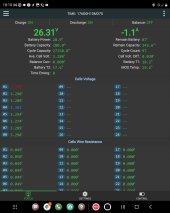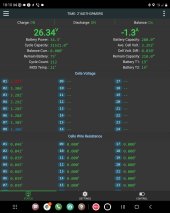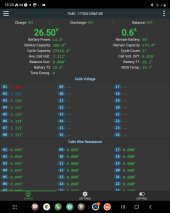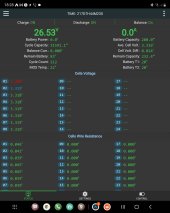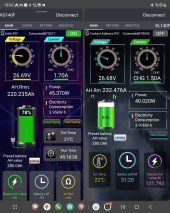Ucatchmydrift
New Member
- Joined
- Jul 2, 2022
- Messages
- 195
Thanks for the detailed explanation! I had to read that a few times lol.You can only effectively balance at the knee. Ignore any cell voltage below 3.5V (or certainly 3.4V).
Bleed off the two runner cells to 3.4V then if you can, charge at a charge current slightly higher than the bleed current at 3.4V and charge until a 3rd cell hits 3.4 while continuing to bleed the two runners.
Now you can stop bleeding and charge the battery until the 3 high cells get up to 3.6 or at least 3.5.
Once you’ve got the highest 3 cells roughly in balance, you can continue the process to get those 3 balanced with the next highest cell, etc…
Once you’ve got the highest 3 or 4 cells in balance, probably time to discharge the battery until a first cell hits the lower knee at 3.0 or at least 3.1V.
If that cell is one of the cells you balanced at the top, that cell is limiting the working capacity of the entire battery and continuing to improve the quality of the top balance will only allow you to increase boost voltage closer to 28.8V but will not gain you any additional capacity.
If another cell hits the lower knee first, boost it’s voltage using a 3.6V power supply until it matches the voltage of the next lowest cell then stop boosting and discharge again until those cells hit the lower knee again).
Now boost both of those cells until they match the voltage of the 3rd-lowest cell.
Repeat the discharge and if none of those 3 bottom-balanced cells hitting the lower knee were one of your 3 top-balanced cells, go ahead and boost all 3 to match the 4th-lowest cell.
Continue to bottom balance to the 5th lowest or even 6th-lowest cell until you have bottom-balanced all lowest cells to the lowest of your 3 top-balanced cells.
You can now charge the full battery back to the top where the first cell to hit the upper knee that was part of the bottom-balanced set is the reference cell determines overall battery capacity and should no longer be touched (neither boosted nor drained).
Boost all other cells to match the voltage of that reference cell.
Getting all the cells balanced to 3.5V should be relatively easy. Getting balanced to 3.6 or even 3.65V just requires a lot of time and attention.
Wherever you end up, that determines your boost voltage and monitoring how quickly the battery strays from that well-balanced starting point will tell you how often you need to go through this painful exercise.
A 5A active balancer that you just attach on whatever schedule you think makes sense is much, much easier…
That is definitely a lot of hastle, and dont really want to be doing that often, or ever tbh. So yes, if a 5a balancer is enough to deal with it, i may well invest in a couple of them. Ill see how much current is needed to stop the two cells from spiking if i can, by draining it off with a load, hopefully 5a or under will be enough, and assuming the cells are not damaged also.
Last edited:




